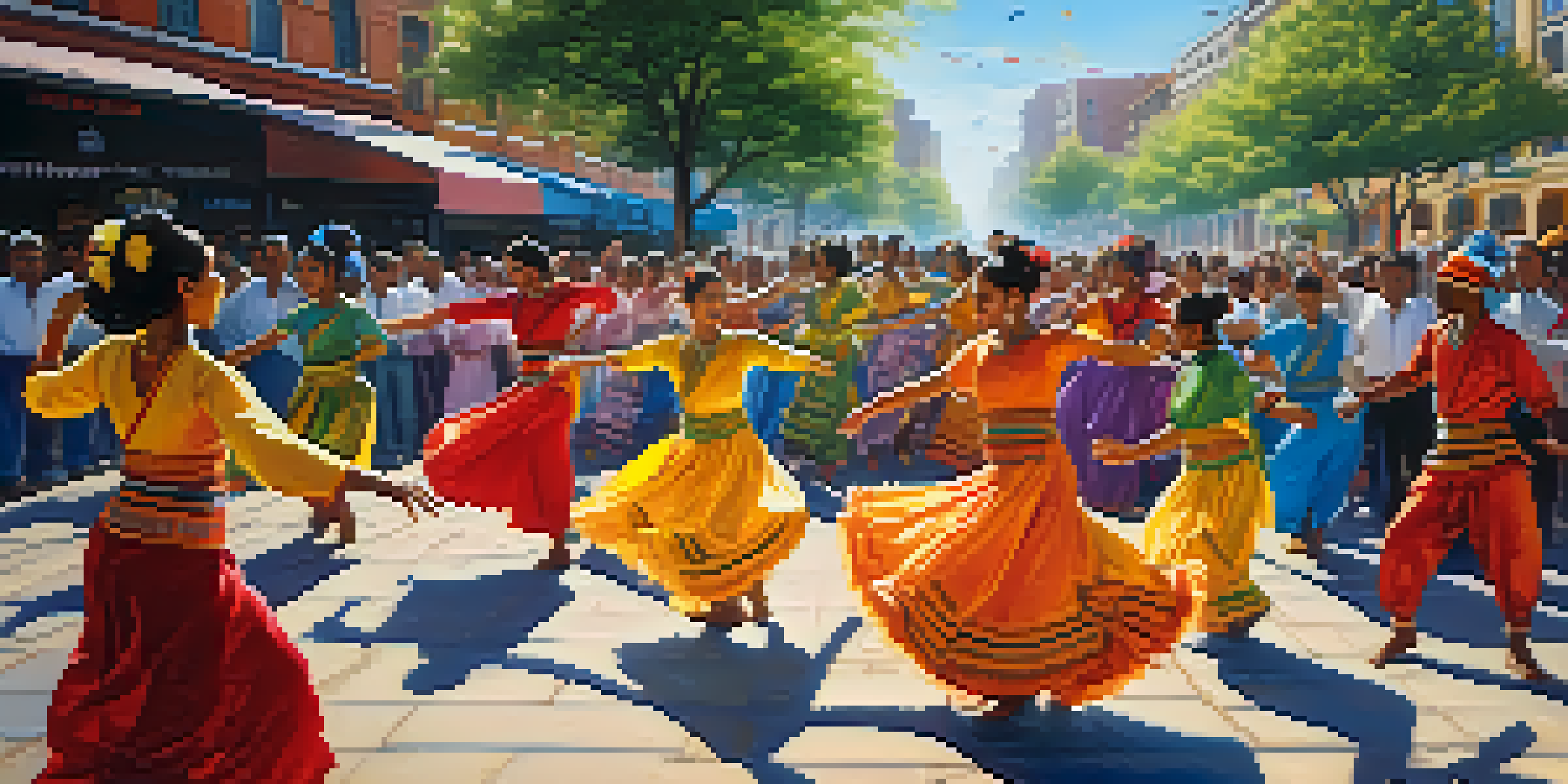The Global Language of Dance: Communicating Across Cultures

Dance as a Universal Form of Expression
Dance transcends spoken language, acting as a universal form of expression. Regardless of culture, people use movement to convey emotions, tell stories, and celebrate life's moments. From a joyful jig in Ireland to a solemn ballet in Russia, each style reflects the unique spirit of its culture.
Dance is the hidden language of the soul.
When we watch a dance performance, we often feel a connection that goes beyond words. This shared experience can evoke feelings of joy, sorrow, or nostalgia, reminding us that emotions are a human experience, not defined by language. For instance, the way a dancer moves can express love or loss, resonating with audiences worldwide.
Moreover, dance often serves as a bridge between cultures, allowing for communication when words fall short. It opens up conversations about identity, history, and community, inviting us to appreciate our differences while celebrating our shared humanity.
The Cultural Significance of Dance
Every culture has its own dances that hold significant meaning, often rooted in tradition and history. For example, the Hula dance in Hawaii tells stories of the land and its people, while the Flamenco in Spain reflects deep emotional experiences. These dance forms are not just performances; they are a reflection of cultural heritage.

Participating in or observing these dances allows individuals to connect with the stories and values of different cultures. This can foster appreciation and understanding, breaking down barriers and promoting empathy among diverse communities. Dance becomes a means of preserving traditions for future generations.
Dance as a Universal Expression
Dance transcends language barriers, allowing people to communicate emotions and stories through movement.
As dance evolves, it often incorporates elements from various cultures, creating new forms that celebrate diversity. This fusion highlights the beauty of cultural exchange, reminding us that while we may come from different backgrounds, our shared experiences can create something truly unique and powerful.
The Role of Dance in Community and Identity
Dance often plays a vital role in community building and personal identity. In many cultures, group dances foster a sense of belonging, allowing individuals to come together to share their heritage. This communal aspect of dance strengthens social bonds and creates lasting memories.
The dance is a poem of which each movement is a word.
For instance, traditional dances performed at festivals or weddings bring families and communities together, creating a shared experience that reinforces cultural identity. When people dance together, they celebrate not just their individual stories but also the collective narrative of their community.
Moreover, dance can be a powerful tool for self-expression and personal identity. Many dancers use their art to explore issues of race, gender, and social justice, turning their performances into statements that resonate with wider audiences. In this way, dance becomes a means of advocating for change and raising awareness.
Dance as a Tool for Social Change
Throughout history, dance has been used as a medium for social change, often addressing pressing issues in society. Movements like the Black Lives Matter have incorporated dance to convey messages of solidarity and resistance. Through choreography, artists can express their hopes and frustrations, uniting people under a common cause.
For example, the viral dance challenges on social media platforms have not only entertained but also raised awareness about social issues. These trends show how dance can adapt to contemporary platforms, reaching diverse audiences and engaging them in important conversations.
Cultural Significance of Dance
Every culture has unique dances that reflect its traditions and history, fostering appreciation and understanding among diverse communities.
Moreover, community-based dance projects often focus on empowerment, particularly in marginalized groups. By providing a space for individuals to express themselves through movement, these initiatives can inspire confidence and foster a sense of agency among participants.
The Healing Power of Dance
Dance has been recognized for its therapeutic benefits, promoting mental and physical well-being. Many therapeutic practices incorporate movement to help individuals express emotions that words cannot capture. This form of expressive therapy is particularly beneficial for those dealing with trauma or mental health issues.
For instance, dance therapy can facilitate self-discovery and healing, allowing participants to reconnect with their bodies and feelings. Through guided movement, individuals can explore their personal narratives, promoting healing on both a physical and emotional level.
Moreover, community dance programs often serve as safe spaces where individuals can find solace and support. By sharing their stories through dance, participants build connections with others, fostering a sense of belonging and resilience.
Globalization and the Evolution of Dance
The rise of globalization has significantly impacted how dance is shared and experienced across cultures. With increased connectivity, dance forms that once belonged to specific regions are now being adopted and adapted globally. This cross-cultural exchange can lead to exciting fusions and new styles that celebrate diversity.
Social media platforms play a pivotal role in this phenomenon, allowing dancers to showcase their work to a global audience. Trends can spread rapidly, encouraging dancers to experiment with different styles and techniques, further enriching the global dance landscape.
Dance for Social Change
Dance has historically been a powerful tool for social change, addressing important issues and empowering marginalized groups.
However, this blending of cultures also raises questions about cultural appropriation and the importance of respecting the origins of certain dance forms. It's crucial to engage with these conversations thoughtfully, ensuring that the appreciation of diverse dances comes from a place of respect and understanding.
The Future of Dance as a Global Language
As we look ahead, the future of dance as a global language appears bright. With ongoing advancements in technology and communication, dance will continue to evolve and adapt, serving as a powerful medium for connection and expression. The potential for collaboration across cultures is immense, fostering creativity and innovation.
Moreover, educational initiatives that focus on dance can promote cultural literacy, encouraging individuals to learn about and appreciate different dance forms. By integrating dance into curricula, we can cultivate a generation that values diversity and understands the significance of movement as a form of communication.

Ultimately, dance will remain a vital part of our shared human experience, bridging gaps and fostering understanding across cultures. As we dance together, we create a tapestry of stories, emotions, and identities that enrich our global community.